Slavic sites abound, but as is to be expected, the most obvious feature of Slavic Washington is the embassies of the twelve Slavic states: Belarus, Bosnia and Hercegovina, Bulgaria, Croatia, Czech Republic, Macedonia, Poland, Russia, Serbia and Montenegro, Slovakia, Slovenia and Ukraine.
 Like any city, Washington has its share of Slavic churches, such as St Nicholas Russian Orthodox Church (OCA).
Like any city, Washington has its share of Slavic churches, such as St Nicholas Russian Orthodox Church (OCA).The massive Basilica of the National Shrine of the Immaculate Conception features a number of chapels dedicated to Slavic Catholic nations, such as the Carpatho-Rusyns (a.k.a. “Byzantine-Ruthenians”, Croats, Czechs, Poles, Slovaks and Slovenes. The Basilica also features Mary, the Immaculate Queen of the Universe, by prominent Croatian sculptor Ivan Mestrovic on its North Façade.
There are also a few restaurants (via Tyler Cowen's Ethnic Dining Guide): Russia House (790 Station Street, Herndon, 787-8880); Russia House (1800 Connecticut Ave., near Florida, 202-234-9433), closed Sunday; Maxim (1725 F Street, NW, 202-962-0280), closed Sunday, business attire required; The Serbian Crown (near historic Colvin Run Mill in Great Falls, VA, 703-759-4150); Restaurant Cosmopolitan (N. Kings Highway, across from Huntington Metro Station); Cafe Sofia (2900 Valley Avenue, Winchester, 703-667-2950), closed Sunday, Saturday lunch; and Bistro Bulgari (509 23rd Street, Crystal City, 703-979-7676).
The largest community seems to be the Russians, led by the Congresss of Russian Americans and informed by the website Russian DC and the newspaper Kontinent. There’s also The Slavic Male Chorus of Washington DC, the Olympus Russian School and the Classika Theatre. And don’t forget Viktor Kamkin bookstore.
More impressively, the Russian community has created the Alley of Russian Poets (outside the Guy Mason Recreation Center, 3600 Calvert Street NW, Glover Park neighborhood, Washington DC), a line of trees planted in memory of Boris Pasternak, Marina Tsvetaeva, Osip Mandelstam, Anna Akhmatova, Nikolai Gumilev, Alexander Pushkin, Mikhail Lermontov, Fyodor Tyutchev, Afanasy Fet, and Alexander Blok. Each tree is marked by a marble plate.
The same group maintains the Literary Museum of the Five Russian Poets of the Silver Age (Rockville, MD). The museum focuses on Tsvetaeva, Mandelstam, Pasternak, Akhmatova and Gumilev. Visitors are welcome by appointment, call 301-942-2728. Another museum is the Hillwood Museum and Galleries (4155 Linnean Avenue, NW, Washington DC), which has one of the largest collections of 18th and 19th century Russian art outside of Russia.
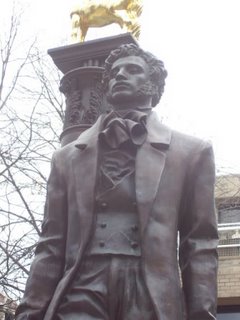 Washington is also home to the first US monument to honor a Russian literary figure – Alexander Pushkin (Corner of 22nd and H Streets on The George Washington University Campus, Foggy Bottom) by sculptor Alexander Bourganov. It was sponsored by the American-Russian Cultural Cooperative Foundation in 2000.
Washington is also home to the first US monument to honor a Russian literary figure – Alexander Pushkin (Corner of 22nd and H Streets on The George Washington University Campus, Foggy Bottom) by sculptor Alexander Bourganov. It was sponsored by the American-Russian Cultural Cooperative Foundation in 2000.
Even though there do not seem to be any Polish restaurants, Poles surely rival the Russians in terms of local presence. Leading organizations include the American Center of Polish Culture, the Polish Library in Washington and the Pope John Paul II Cultural Center. The community stays in touch via Polish Washington and Polish Happy Hour organizes meet-ups regularly.
Washington is also home to statues commemorating Tadeusz Kosciuszko (Lafayette Park, H Street and 16th, Washington, DC, by sculptor Antoni Popiel, 1910) and Kasimir Pulaski (Freedom Plaza, Pennsylvania Avenue and 13th, by sculptor Kasimiriez Chodzinski, 1910).
 Thanks to the American Friends of the Czech Republic, the Tomas Garrigue Masaryk Memorial Statue (at The World Bank, 1818 H Street, NW, Washington DC, near Pennsylvania Avenue) was unveiled on 19 September 2002, and the construction of the surrounding park was completed in March 2004. There is also a Masaryk Commemorative Plaque at Hotel 2400 (now Hotel Envoy, 2400 16th Street, Washington DC), commemorating T. G. Masaryk’s stay in Washington in 1918.
Thanks to the American Friends of the Czech Republic, the Tomas Garrigue Masaryk Memorial Statue (at The World Bank, 1818 H Street, NW, Washington DC, near Pennsylvania Avenue) was unveiled on 19 September 2002, and the construction of the surrounding park was completed in March 2004. There is also a Masaryk Commemorative Plaque at Hotel 2400 (now Hotel Envoy, 2400 16th Street, Washington DC), commemorating T. G. Masaryk’s stay in Washington in 1918.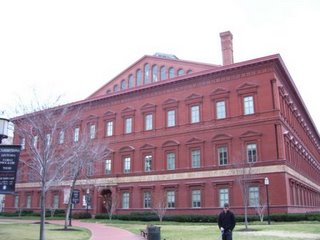
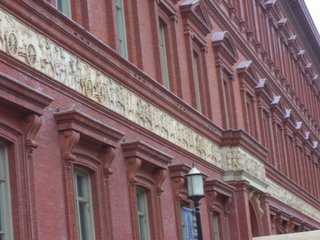 Elsewhere in town, a Czech was responsible for the amazing frieze that runs around the whole exterior of the National Building Museum (401 F Street NW). Casper Buberl was born in Bohemia and is the creator of a number of works throughout the US.
Elsewhere in town, a Czech was responsible for the amazing frieze that runs around the whole exterior of the National Building Museum (401 F Street NW). Casper Buberl was born in Bohemia and is the creator of a number of works throughout the US.

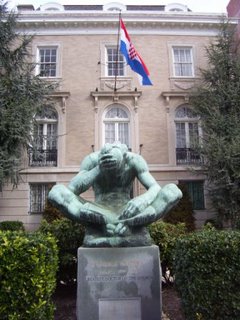 Croatia’s Ivan Mestrovic also contributed a statue of St. Jerome the Priest (Sheridan Circle, Massachusetts Avenue and 24th) to Washington in 1954. The Croatian community also maintains The Croatian League of Young Professionals and Croatian House.
Croatia’s Ivan Mestrovic also contributed a statue of St. Jerome the Priest (Sheridan Circle, Massachusetts Avenue and 24th) to Washington in 1954. The Croatian community also maintains The Croatian League of Young Professionals and Croatian House.
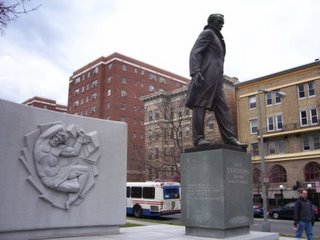 Ukrainians have The Washington Group and the U.S.-Ukraine Foundation. There is also a monument to national poet Taras Shevchenko (22d, 23d and P Streets, NW, Washington, DC) by sculptor Leo Mol and architect Radoslav Zuk, unveiled on 27 June 1964 by President Eisenhower.
Ukrainians have The Washington Group and the U.S.-Ukraine Foundation. There is also a monument to national poet Taras Shevchenko (22d, 23d and P Streets, NW, Washington, DC) by sculptor Leo Mol and architect Radoslav Zuk, unveiled on 27 June 1964 by President Eisenhower.
The Carpatho-Rusyn Society National Capital Chapter is the central organization for the group, and through 20 February the Corcoran Gallery of Art (500 17th Street, NW, Washington DC) is featuring the nation’s most famous son, Andy Warhol with The Warhol Legacy: Selections from The Andy Warhol Museum.
The other Slavic groups are less represented. Bulgarians have the Bulgarian DC Society and the Ivan Dimitrov Dance Ensemble. The Serbian Unity Congress maintains a Washington Office, Washington Project and a Washington Chapter. There are also the Macedonian Association of Students and Young Professionals of Washington, D.C. and also Bosnian Handicrafts.
And somehow it seems appropriate to mention the International Spy Museum (800 F Street NW, Washington DC), as well.







No comments:
Post a Comment